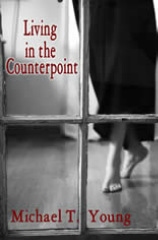nycBigCityLit.com the rivers of it, abridged


Reviews
Spring 2013
Living in the Counterpoint
by Michael T. Young

Living in the Counterpoint
by Michael T. Young
Finishing Line Press, 2012; 23 pages; $12.00
ISBN: 1-59924-870-0/ISBN: 978-1-59924-870-7), paper
http://www.michaeltyoung.com/books.html
Reviewed by Richard Levine
Michael T. Young's Living in the Counterpoint has the distinction, far too uncommon in poetry books, of actually having a clearly guiding theme. Each poem presents a self—contained exploration of living in the counterpoint, and becomes a counterpoint to each subsequent poem. The poems do not look the same, but I found and enjoyed the theme-wise format shared by most of them — imagining for the reader a string of comparisons to an initial image, often of setting and sensibility. Then, just as the engaging and varied comparisons were making me "… wondering if I'd make it home" … along came " … a passage, a theme, a point to it all." I was equally impressed by the sequence of poems that take the reader from the already quoted doubt of returning home — which appears in the first poem — to the book's comforting last line, "… like bells calling me home"; a sort of bookend counterpoint.
In the course of the book's journey — out into doubt and back again — there's another, darker, ironic sort of counterpoint that I enjoyed as well. I'm not sure I can explain the way I experienced this in the poems; perhaps this is one of those areas that poetry and poetry alone can serve. Counterpoint, in simplest terms, is a combining, as with a second or counter melody or rhythm. But in that second or counter, one might sense a contrariness and I think Young plants that dual vision—sense for us to resolve for ourselves. I sensed both the combining and contrary aspects of counterpoint in many of the poems. Though I could probably point to a passage in many of the book's poems, here's an example from "Directions." In it, the poem's narrator is reading on a train and notices that the person sitting beside him is reading in Chinese. The narrator's thoughts travel to and stop at many left—right and up—down stations posed by the pages, before "… observing our contrary motions mirror each other's gestures of comprehension."
The use of the words "contrary" and "other" in that line create a distance that is not dissolved by "comprehension" and that keeps the poem rooted in reality rather than making it a kum ba ya moment. It's as if Young is showing the reader the common ground surrounding us, and it made me think of the spit of ground upon which a dove finds a twig and returns it to Noah … the world is still underwater and dangerous, yet in that moment possibility becomes a stronger force than the flood. And, yes, we sense the crow still out there, too … beyond doubt? Counterpoint: combining and contrary, does that get it?
It's also appealing the way the poems rise from "… the daily infancy from which we crawl …" to "reach down the throat of event into the minutiae" …" of ordinary days, moments and dreams of daring, memories of travel and loved ones, and the way Young makes mantras of the beauty of experience even in "a … moment of being lost" — which recalled several poems and poets. First, William Stafford's "The Day Millicent Found the World". In fact, there are many moments in the book that remind me of an urban-eyed Stafford. Also, Horace: the pleasure of experience, the experience of pleasure.
Does Living in the Counterpoint also suggest that amid all the beauty and pleasure to partake of we can't ever get as close as we'd want? There is a line which the poems do not cross in approaching each subject. Is this part of the book's closely constructed structure and theme or a shortcoming? My vote goes to it being part of Young's plan: there must be an unbridgeable space between point and counterpoint. Though the poems are very well made, the quality in them that I find most appealing is the sense that the writer's discovery of each of the poems is still very much alive in them. This is very exciting to read and very difficult to write, because the poet must refine without ornamenting the raw inspiration, and Young wisely stays the more conservative editorial hand from limiting surprise and spontaneity, so there is a newness in each delivery of his counterpoints.
Beyond all the pleasing particulars and intangibles, I just like the writing and the book's idea, the inventiveness of vision, vocabulary and syntax, the integration of word—sounds and word—pictures; all the poems are self—standing, as well as doing the hard brick—and—mortar work of making a solid structure of a theme. Michael T. Young's Living in the Counterpoint is a built like a sturdy house with plenty of windows and comfortable furnishings, a house intended not as a fortress against the world, but a shelter for living fully in it; in this house, you can walk in and sit down and have a fine read.
Richard Levine is author of A Tide of a Hundred Mountains (Bright Hill Press, 2012), as well as That Country's Soul, A Language Full of Wars and Songs, and Snapshots from a Battle. His poem "Believe This" was featured in former Poet Laureate Ted Kooser's column, "American Life in Poetry". In 2010, Mr. Levine was runner-up for the William Stafford Award for Poetry. A retired teacher, he spends most days working to block hydro-fracking in New York State.